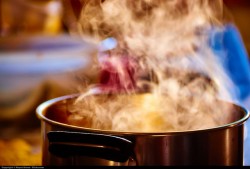
For most of my adult life I’ve despised making dinner.
I made sure my mate was as close to a chef as humanly possible, minus the Gordon Ramsay personality. As a mother I conditioned the kids to prefer noodles with butter and primarily the food their dad prepared.
On my own I eat salad, with a side of salad and a piece of toast. As a member of a family of four, that isn’t polite or beneficial to a diverse palate. Cooking became a dreaded experience and the outcome was the food I served tasted bland and uninspiring—sustenance only.
The other three and I made do, until I came up with a new way to make cooking if not fun, at least interesting. The 2000 movie Chocolat, a 50th birthday trip to Costa Rica to learn shamanism, and an unintended soup bomb inspired my development of intentional cooking.
In the movie, Juliette Binoche and her daughter open a chocolate shop in a French village with judgment issues. The people of the town are changed by the mysterious sweets, laced with the candy maker’s good intentions.
At my half century mark, in Costa Rica at a shack resembling Moondoggie’s in the Gidget movies, I began to see the correlation between where I focused and the outcome. Shamanism at its root is about the power of an intention. It is a way to bring our attention to our intentions.
Back home from shamanic training, this lit a fire under my burner for creative cooking.
I began to see the intake of food as more than fuel, no different than when I practiced as a CranioSacral therapist or drummed a shamanic blessing. Grocery shopping shifted into a mystical experience, as did making a cauldron of oats.
This is about when I had my encounter with the soup bomb. I wrote about it in detail in another post two years ago. In mid-meal with friends, at the bottom of a delicious bowl of soup, I learned from the hostess that the chicken and wild rice concoction had been used in a ceremonial generational cleanse she had participated in.
My response at the time had been an internal uh-oh. The powerful soup did as it was intended, with or without my involvement. The experience graphically illustrated the importance of a considered intention and that it also includes free will.
Over time I culled what worked or had a beneficial impact on those who ate what I prepared, from what were just the ramblings of my creative, if not slightly askew mind.
I share the top five highlights with the intention of good health and healing for other members of my dreaded cooking tribe.
Prep: Set an intention. This can be along the lines of Chocolat, to inspire an emotion or something deeper, like helping to heal an illness, creating opportunity for change or simply bringing more light into the awareness of our world.
Be thoughtful, respectful and kind. No one wants a soup bomb without their consent. In my case it was an accidental occurrence, the hostess hadn’t known the ceremonial soup could impact others.
It is important to pay attention and be kind when bringing food to ourselves and others. It isn’t considerate of a person’s experience to choose an intention for them.
Carry the intention to the grocery store. It’s easy to shop when a meal is under the heading “joy.” Fruit appears vibrantly lit and vegetables intensely colored. Perfect items seem to leap into the grocery cart, while those not for the meal remain on the shelf.
Offer gratitude for the energy source the items provide. Native Americans did this before and after the hunt. Give thanks while gathering items at the store, during preparation, and while serving the meal.
State the intention to the members at your table. Enable those readying to consume what has been made, to join the intention or inspire on of their own.
I choose health, healing and gratitude.
~
Author: Deb Lecos
Editor: Catherine Monkman
Image: Moyan Brenn/Flickr, Pixoto











Read 1 comment and reply